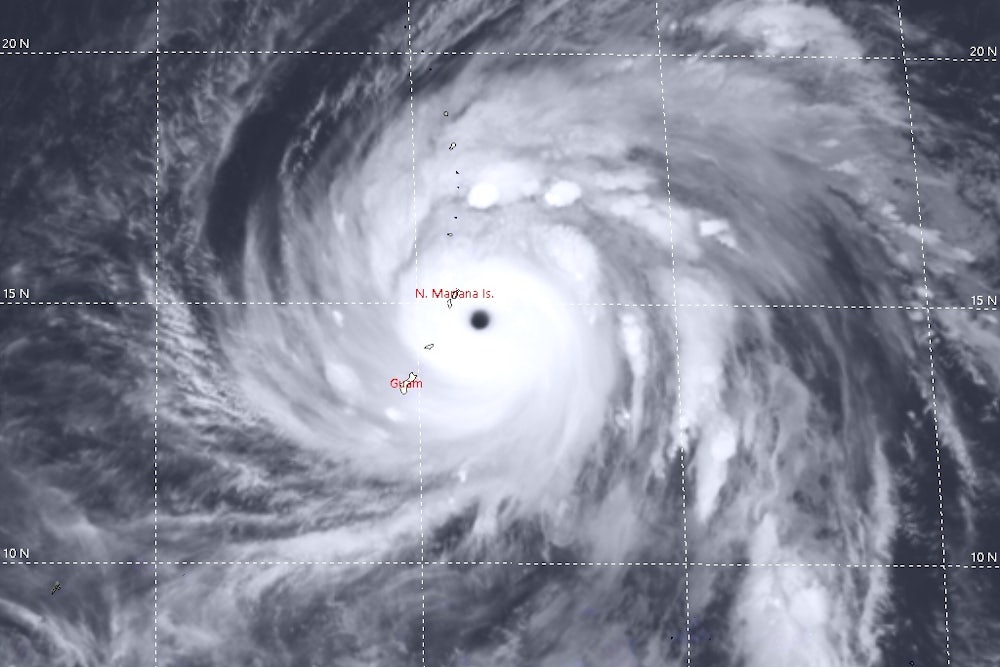A record-breaking hurricane slams into a United States territory. The U.S. government is supposed to respond to the damage. But the government is overstretched, and the island is remote. Amid poor transportation, the response suffers. Thousands die.
This might sound like the story of Puerto Rico and Hurricane Maria. But it could easily become the story of the Northern Mariana Islands and Super Typhoon Yutu, a Category 5-equivalent storm that passed over the U.S. territory in the Pacific Ocean on Wednesday. In the northwest Pacific, hurricanes are called typhoons; super typhoons are hurricanes with sustained winds above 150 miles per hour. And based on early estimations, Super Typhoon Yutu may be the strongest hurricane to ever hit U.S. soil, a devastating reminder both of the precarious, second-class citizen position of U.S. territories and of the storm readiness issues the U.S. will have to face as climate change accelerates.
Yutu is certainly the strongest storm to form on earth this year. With sustained winds of up to 180 miles per hour, it’s also “likely to be unprecedented in modern history for the Northern Mariana Islands ... home to slightly more than 50,000 people,” according to The Washington Post. The majority of those people live on the island of Saipan—which the storm’s inner eyewall directly passed over—along with the smaller island of Tinian.
Judging from the crickets on major U.S. news sites, who would ever know that a hurricane (#Yutu) is expected to slam into a U.S. commonwealth as a Category 5 storm in about 12 hours? Most of the 53,000 residents of the #northernmarianas are U.S. citizens https://t.co/HSBnZqcxy3 pic.twitter.com/FPGettue3K
— Bob Henson (@bhensonweather) October 24, 2018
The degree of damage is yet unclear. But Michael Lowry, a strategic planner for the Federal Emergency Management Agency (FEMA), predicted a “devastating strike” on Saipan. “This is a historically significant event,” he tweeted, calling Yutu “one of the most intense tropical cyclones we’ve observed worldwide in the modern record.”
Smaller storms have also wreaked havoc on Saipan in the past; Typhoon Soudelor hit Saipan in 2015 with maximum sustained winds of 105 miles per hour and wiped out much of the island’s power infrastructure. A month before that, another typhoon passed over the island and “disconnected an undersea cable, effectively severing communications between the Northern Mariana Islands and the rest of the world for a few days,” HuffPost reported at the time.

Response and recovery will likely prove challenging. Saipan and Tinian are extremely remote; the closest large countries are Japan and the Philippines, both of which are more than 1,000 miles away. Hawaii, nearly 4,000 miles away, is the closest U.S. state. FEMA thus considers the Northern Mariana Islands an “insular area,” meaning they face “unique challenges in receiving assistance from outside the jurisdiction quickly.”
Yutu is also striking at the worst possible time. The islands already recovering from Super Typhoon Mangkhut, which slammed into the territory with 105 miles per hour winds last month. Mangkhut prompted President Donald Trump to sign a major disaster declaration for the islands, making federal funding available for both temporary and permanent rebuilding. But a major disaster declaration has not yet been declared for Yutu—only an emergency declaration, which makes federal money available for “debris removal” and “emergency protective measures.”
It’s likely Trump will issue a major disaster declaration for Yutu eventually. But if the past is any indication, it might take a while. His major disaster declaration for Mangkhut, for instance, didn’t come until September 29th—and the storm hit the islands on September 10. Trump was also criticized for his slow response to Hurricane Maria in Puerto Rico—another remote island U.S. territory that was struggling to recover from an earlier storm when it was hit by an even stronger one. Hopefully, the administration has learned how deadly delay can be.
